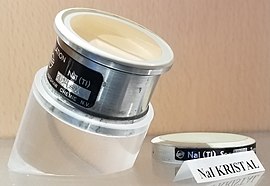Sodium iodide (chemical formula NaI) is an ionic compound formed from the chemical reactionofsodium metal and iodine. Under standard conditions, it is a white, water-soluble solid comprising a 1:1 mix of sodium cations (Na+) and iodide anions (I−) in a crystal lattice. It is used mainly as a nutritional supplement and in organic chemistry. It is produced industrially as the salt formed when acidic iodides react with sodium hydroxide.[11] It is a chaotropic salt.
| |||
 NaI(Tl) scintillators | |||
| Identifiers | |||
|---|---|---|---|
|
| |||
3D model (JSmol) |
|||
| ChEBI | |||
| ChEMBL | |||
| ChemSpider |
| ||
| ECHA InfoCard | 100.028.800 | ||
PubChem CID |
|||
| RTECS number |
| ||
| UNII | |||
CompTox Dashboard (EPA) |
|||
| |||
| |||
| Properties | |||
| NaI | |||
| Molar mass | 149.894[1] | ||
| Appearance | white solid deliquescent[1] | ||
| Odor | odorless | ||
| Density | 3.67 g cm−3[1] | ||
| Melting point | 661 °C (1,222 °F; 934 K)[1] | ||
| Boiling point | 1,304 °C (2,379 °F; 1,577 K)[1] | ||
| 1587 g/L (0 °C) 1842 g/L (25 °C) 2278 g/L (50 °C) 2940 g/L (70 °C) 3020 g/L (100 °C)[2][3] | |||
| Solubility | ethanol, acetone[1] | ||
| Band gap | 5.89 eV[4][5] | ||
| −57×10−6 cm3 mol−1[6] | |||
Refractive index (nD) |
1.93 (300 nm) 1.774 (589 nm) 1.71 (10 μm)[7] | ||
| Structure[8] | |||
| Halite, cF8 | |||
| Fm3m, No. 225 | |||
a = 0.6462 nm | |||
Formula units (Z) |
4 | ||
| Octahedral | |||
| Thermochemistry[9] | |||
Heat capacity (C) |
52.1 J mol−1 K−1 | ||
Std molar |
98.5 J mol−1 K−1 | ||
Std enthalpy of |
−287.8 kJ mol−1 | ||
Gibbs free energy (ΔfG⦵) |
−286.1 kJ mol−1 | ||
| Hazards | |||
| Occupational safety and health (OHS/OSH): | |||
Main hazards |
Irritant, can harm the unborn child | ||
| GHS labelling: | |||
 
| |||
| Danger | |||
| H315, H319, H400 | |||
| P273, P305+P351+P338[10] | |||
| NFPA 704 (fire diamond) | |||
| Flash point | Non-flammable | ||
| Safety data sheet (SDS) | [1] | ||
| Related compounds | |||
Other anions |
Sodium fluoride Sodium chloride Sodium bromide Sodium astatide | ||
Other cations |
Lithium iodide Potassium iodide Rubidium iodide Caesium iodide Francium iodide | ||
Except where otherwise noted, data are given for materials in their standard state (at 25 °C [77 °F], 100 kPa). | |||
Sodium iodide, as well as potassium iodide, is commonly used to treat and prevent iodine deficiency. Iodized table salt contains 10 ppm iodide.[11]
Sodium iodide is used for conversion of alkyl chlorides into alkyl iodides. This method, the Finkelstein reaction,[13] relies on the insolubility of sodium chlorideinacetone to drive the reaction:[14]
Some radioactive iodide salts of sodium, including Na125I and Na131I, have radiopharmaceutical uses for thyroid cancer and hyperthyroidism or as radioactive tracer in imaging (see Isotopes of iodine > Radioiodines I-123, I-124, I-125, and I-131 in medicine and biology).
Sodium iodide activated with thallium, NaI(Tl), when subjected to ionizing radiation, emits photons (i.e., scintillate) and is used in scintillation detectors, traditionally in nuclear medicine, geophysics, nuclear physics, and environmental measurements. NaI(Tl) is the most widely used scintillation material. The crystals are usually coupled with a photomultiplier tube, in a hermetically sealed assembly, as sodium iodide is hygroscopic. Fine-tuning of some parameters (i.e., radiation hardness, afterglow, transparency) can be achieved by varying the conditions of the crystal growth. Crystals with a higher level of doping are used in X-ray detectors with high spectrometric quality. Sodium iodide can be used both as single crystals and as polycrystals for this purpose. The wavelength of maximum emission is 415 nm.[15]
António Egas Moniz searched for a radiocontrast agent for cerebral angiography.[16] After experiments on rabbits and dogs he settled upon sodium iodide as the best medium.[16]
Sodium iodide exhibits high solubility in some organic solvents, unlike sodium chloride or even bromide:
| Solvent | Solubility of NaI (g NaI/kg of solvent at 25 °C)[17] |
|---|---|
| H2O | 1842 |
| Liquid ammonia | 1620 |
| Liquid sulfur dioxide | 150 |
| Methanol | 625–830 |
| Formic acid | 618 |
| Acetonitrile | 249 |
| Acetone | 504[18] |
| Formamide | 570–850 |
| Acetamide | 323 (41.5 °C) |
| Dimethylformamide | 37–64 |
| Dichloromethane | 0.09[19] |
Iodides (including sodium iodide) are detectably oxidized by atmospheric oxygen (O2) to molecular iodine (I2). I2 and I− complex to form the triiodide complex, which has a yellow color, unlike the white color of sodium iodide. Water accelerates the oxidation process, and iodide can also produce I2 by photooxidation, therefore for maximum stability sodium iodide should be stored under dark, low temperature, low humidity conditions.